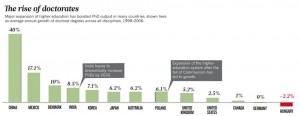I came across this chapter from a report from the Pew Research Centre on
Is College Worth It?. The report looks at the value of education over a lifetime of work and concludes that “The typical college graduate earns an estimated $650,000 more than the typical high school graduate over the course of a 40-year work life…”
This chapter is part of a larger report on The Value of College. The authors make a number of points:
- “A majority of Americans (57%) say the higher education system in the United States fails to provide good value for the money students and their families spend, and about four-in-ten college presidents say the system is headed in the wrong direction”
- “just 19% of the 1,055 college presidents surveyed say they believe that the U.S. system of higher education is the best in the world. And just 7% say they think it will be the best in the world 10 years from now.”
- “most college presidents (52%) say college students today study less than their predecessors did a decade ago, while just 7% say they study more. And 58% say that public high schools are doing a worse job of preparing students for college now than they did a decade ago, while just 6% say they are doing a better job.”
- “the Pew Research survey finds that college graduates, on average, are happier and more satisfied with their jobs, their financial situation and their education than are those who did not attend college.”
- “When asked what it takes for a young person to succeed in the world, more people point to traits such as a good work ethic (61% say this is extremely important) and knowing how to get along with people (57%) than say the same about a college education (42%).”
- “the cost of a college education—at both public and private institutions—has roughly tripled since 1980 in inflation-adjusted dollars”
- “By a small but statistically significant margin, the public says that the main purpose of a college education should be to teach work-related skills and knowledge (47%) rather than to help an individual grow personally and intellectually (39%). … College graduates tend to place more emphasis on personal and intellectual growth (52%) over career preparation (35%), while those who are not college graduates lean the other way, emphasizing career preparation (51%) over personal growth (34%).”
All of these quotes are from the Overview of the full report.




